What is JDBC?
JDBC stands for Java Database Connectivity, which is a standard Java API for database-independent connectivity between the Java programming language and a wide range of databases.
The JDBC library includes APIs for each of the tasks commonly associated with database usage:
- Making a connection to a database
- Creating SQL or MySQL statements
- Executing that SQL or MySQL queries in the database
- Viewing & Modifying the resulting records
Fundamentally, JDBC is a specification that provides a complete set of interfaces that allows for portable access to an underlying database. Java can be used to write different types of executables, such as:
- Java Applications
- Java Applets
- Java Servlets
- Java ServerPages (JSPs)
- Enterprise JavaBeans (EJBs)
All of these different executables are able to use a JDBC driver to access a database and take advantage of the stored data.
JDBC provides the same capabilities as ODBC, allowing Java programs to contain database-independent code.
Pre-Requisite:
Before progressing on this tutorial you need to have good understanding on the following two subjects:
JDBC Architecture:
The JDBC API supports both two-tier and three-tier processing models for database access but in general JDBC Architecture consists of two layers:
- JDBC API: This provides the application-to-JDBC Manager connection.
- JDBC Driver API: This supports the JDBC Manager-to-Driver Connection.
The JDBC API uses a driver manager and database-specific drivers to provide transparent connectivity to heterogeneous databases.
The JDBC driver manager ensures that the correct driver is used to access each data source. The driver manager is capable of supporting multiple concurrent drivers connected to multiple heterogeneous databases.
Following is the architectural diagram, which shows the location of the driver manager with respect to the JDBC drivers and the Java application:
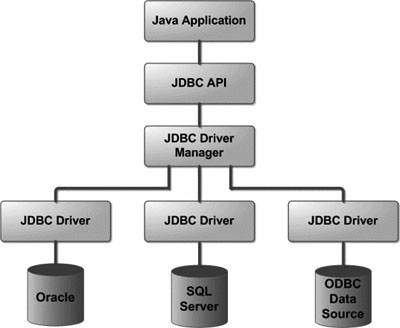
Common JDBC Components:
The JDBC API provides the following interfaces and classes:
- DriverManager: This class manages a list of database drivers. Matches connection requests from the java application with the proper database driver using communication subprotocol. The first driver that recognizes a certain subprotocol under JDBC will be used to establish a database Connection.
- Driver: This interface handles the communications with the database server. You will interact directly with Driver objects very rarely. Instead, you use DriverManager objects, which manages objects of this type. It also abstracts the details associated with working with Driver objects
- Connection : This interface with all methods for contacting a database. The connection object represents communication context, i.e., all communication with database is through connection object only.
- Statement : You use objects created from this interface to submit the SQL statements to the database. Some derived interfaces accept parameters in addition to executing stored procedures.
- ResultSet: These objects hold data retrieved from a database after you execute an SQL query using Statement objects. It acts as an iterator to allow you to move through its data.
- SQLException: This class handles any errors that occur in a database application.
The JDBC 4.0 Packages
The java.sql and javax.sql are the primary packages for JDBC 4.0. This is the latest JDBC version at the time of writing this tutorial. It offers the main classes for interacting with your data sources.
The new features in these packages include changes in the following areas:
- Automatic database driver loading
- Exception handling improvements
- Enhanced BLOB/CLOB functionality
- Connection and statement interface enhancements
- National character set support
- SQL ROWID access
- SQL 2003 XML data type support
- Annotations
What is JDBC Driver ?
JDBC drivers implement the defined interfaces in the JDBC API for interacting with your database server.
For example, using JDBC drivers enable you to open database connections and to interact with it by sending SQL or database commands then receiving results with Java.
The Java.sql package that ships with JDK contains various classes with their behaviours defined and their actual implementaions are done in third-party drivers. Third party vendors implements the java.sql.Driver interface in their database driver.
JDBC Drivers Types:
JDBC driver implementations vary because of the wide variety of operating systems and hardware platforms in which Java operates. Sun has divided the implementation types into four categories, Types 1, 2, 3, and 4, which is explained below:
Type 1: JDBC-ODBC Bridge Driver:
In a Type 1 driver, a JDBC bridge is used to access ODBC drivers installed on each client machine. Using ODBC requires configuring on your system a Data Source Name (DSN) that represents the target database.
When Java first came out, this was a useful driver because most databases only supported ODBC access but now this type of driver is recommended only for experimental use or when no other alternative is available.
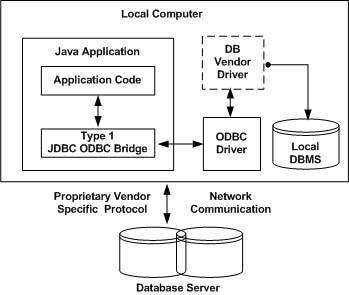
Type 2: JDBC-Native API:
In a Type 2 driver, JDBC API calls are converted into native C/C++ API calls which are unique to the database. These drivers typically provided by the database vendors and used in the same manner as the JDBC-ODBC Bridge, the vendor-specific driver must be installed on each client machine.
If we change the Database we have to change the native API as it is specific to a database and they are mostly obsolete now but you may realize some speed increase with a Type 2 driver, because it eliminates ODBC's overhead.
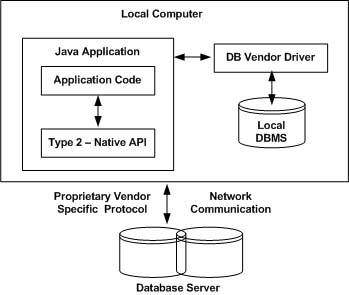
Type 3: JDBC-Net pure Java:
In a Type 3 driver, a three-tier approach is used to accessing databases. The JDBC clients use standard network sockets to communicate with an middleware application server. The socket information is then translated by the middleware application server into the call format required by the DBMS, and forwarded to the database server.
This kind of driver is extremely flexible, since it requires no code installed on the client and a single driver can actually provide access to multiple databases.
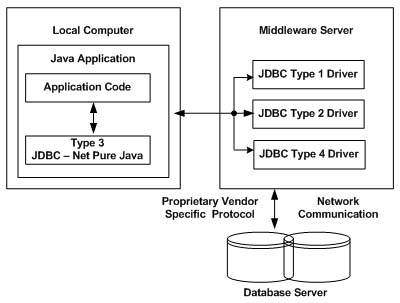
Your application server might use a Type 1, 2, or 4 driver to communicate with the database, understanding the nuances will prove helpful.
Type 4: 100% pure Java:
In a Type 4 driver, a pure Java-based driver that communicates directly with vendor's database through socket connection. This is the highest performance driver available for the database and is usually provided by the vendor itself.
This kind of driver is extremely flexible, you don't need to install special software on the client or server. Further, these drivers can be downloaded dynamically.
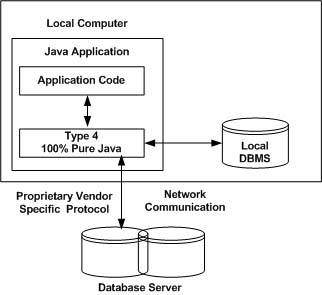
Which Driver should be used?
If you are accessing one type of database, such as Oracle, Sybase, or IBM, the preferred driver type is 4.
If your Java application is accessing multiple types of databases at the same time, type 3 is the preferred driver.
Type 2 drivers are useful in situations where a type 3 or type 4 driver is not available yet for your database.
The type 1 driver is not considered a deployment-level driver and is typically used for development and testing purposes only.
After you've installed the appropriate driver, it's time to establish a database connection using JDBC.
The programming involved to establish a JDBC connection is fairly simple. Here are these simple four steps:
- Import JDBC Packages: Add import statements to your Java program to import required classes in your Java code.
- Register JDBC Driver: This step causes the JVM to load the desired driver implementation into memory so it can fulfill your JDBC requests.
- Database URL Formulation: This is to create a properly formatted address that points to the database to which you wish to connect.
- Create Connection Object: Finally, code a call to the DriverManager object'sgetConnection( ) method to establish actual database connection.
Import JDBC Packages:
The Import statements tell the Java compiler where to find the classes you reference in your code and are placed at the very beginning of your source code.
To use the standard JDBC package, which allows you to select, insert, update, and delete data in SQL tables, add the following imports to your source code:
import java.sql.* ; // for standard JDBC programs import java.math.* ; // for BigDecimal and BigInteger supportRegister JDBC Driver:
You must register the your driver in your program before you use it. Registering the driver is the process by which the Oracle driver's class file is loaded into memory so it can be utilized as an implementation of the JDBC interfaces.
You need to do this registration only once in your program. You can register a driver in one of two ways.
Approach (I) - Class.forName():
The most common approach to register a driver is to use Java's Class.forName() method to dynamically load the driver's class file into memory, which automatically registers it. This method is preferable because it allows you to make the driver registration configurable and portable.
The following example uses Class.forName( ) to register the Oracle driver:
You can use getInstance() method to work around noncompliant JVMs, but then you'll have to code for two extra Exceptions as follows:try { Class.forName("oracle.jdbc.driver.OracleDriver"); } catch(ClassNotFoundException ex) { System.out.println("Error: unable to load driver class!"); System.exit(1); }
try { Class.forName("oracle.jdbc.driver.OracleDriver").newInstance(); } catch(ClassNotFoundException ex) { System.out.println("Error: unable to load driver class!"); System.exit(1); catch(IllegalAccessException ex) { System.out.println("Error: access problem while loading!"); System.exit(2); catch(InstantiationException ex) { System.out.println("Error: unable to instantiate driver!"); System.exit(3); }Approach (II) - DriverManager.registerDriver():
The second approach you can use to register a driver is to use the staticDriverManager.registerDriver() method.
You should use the registerDriver() method if you are using a non-JDK compliant JVM, such as the one provided by Microsoft.
The following example uses registerDriver() to register the Oracle driver:
try { Driver myDriver = new oracle.jdbc.driver.OracleDriver(); DriverManager.registerDriver( myDriver ); } catch(ClassNotFoundException ex) { System.out.println("Error: unable to load driver class!"); System.exit(1); }Database URL Formulation:
After you've loaded the driver, you can establish a connection using theDriverManager.getConnection() method. For easy reference, let me list the three overloaded DriverManager.getConnection() methods:
- getConnection(String url)
- getConnection(String url, Properties prop)
- getConnection(String url, String user, String password)
Formulating a database URL is where most of the problems associated with establishing a connection occur.
Following table lists down popular JDBC driver names and database URL.
All the highlighted part in URL format is static and you need to change only remaining part as per your database setup.RDBMS JDBC driver name URL format MySQL com.mysql.jdbc.Driver jdbc:mysql://hostname/ databaseName ORACLE oracle.jdbc.driver.OracleDriver jdbc:oracle:thin:@hostname:port Number:databaseName DB2 COM.ibm.db2.jdbc.net.DB2Driver jdbc:db2:hostname:port Number/databaseName Sybase com.sybase.jdbc.SybDriver jdbc:sybase:Tds:hostname: port Number/databaseName
Create Connection Object:
Using a database URL with a username and password:
I listed down three forms of DriverManager.getConnection() method to create a connection object. The most commonly used form of getConnection() requires you to pass a database URL, a username, and a password:
Assuming you are using Oracle's thin driver, you'll specify a host:port:databaseName value for the database portion of the URL.
If you have a host at TCP/IP address 192.0.0.1 with a host name of amrood, and your Oracle listener is configured to listen on port 1521, and your database name is EMP, then complete database URL would then be:
Now you have to call getConnection() method with appropriate username and password to get aConnection object as follows:jdbc:oracle:thin:@amrood:1521:EMP
String URL = "jdbc:oracle:thin:@amrood:1521:EMP"; String USER = "username"; String PASS = "password" Connection conn = DriverManager.getConnection(URL, USER, PASS);Using only a database URL:
A second form of the DriverManager.getConnection( ) method requires only a database URL:
However, in this case, the database URL includes the username and password and has the following general form:DriverManager.getConnection(String url);
So the above connection can be created as follows:jdbc:oracle:driver:username/password@database
String URL = "jdbc:oracle:thin:username/password@amrood:1521:EMP"; Connection conn = DriverManager.getConnection(URL);Using a database URL and a Properties object:
A third form of the DriverManager.getConnection( ) method requires a database URL and a Properties object:
A Properties object holds a set of keyword-value pairs. It's used to pass driver properties to the driver during a call to the getConnection() method.DriverManager.getConnection(String url, Properties info);
To make the same connection made by the previous examples, use the following code:
import java.util.*; String URL = "jdbc:oracle:thin:@amrood:1521:EMP"; Properties info = new Properties( ); info.put( "user", "username" ); info.put( "password", "password" ); Connection conn = DriverManager.getConnection(URL, info);Closing JDBC connections:
At the end of your JDBC program, it is required explicitly close all the connections to the database to end each database session. However, if you forget, Java's garbage collector will close the connection when it cleans up stale objects.
Relying on garbage collection, especially in database programming, is very poor programming practice. You should make a habit of always closing the connection with the close() method associated with connection object.
To ensure that a connection is closed, you could provide a finally block in your code. A finallyblock always executes, regardless if an exception occurs or not.
To close above opened connection you should call close() method as follows:
Explicitly closing a connection conserves DBMS resources, which will make your database administrator happy.conn.close();
NOTE:- IF U GET MORE DETAILS http://www.javatpoint.com/jdbc-tutorial